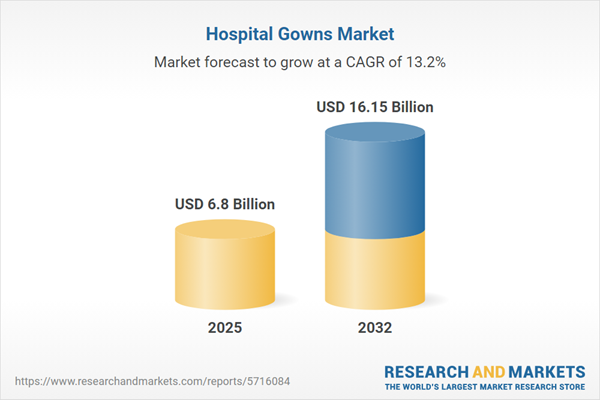Speak directly to the analyst to clarify any post sales queries you may have.
Senior decision-makers in healthcare are navigating a rapidly changing hospital gowns market where procurement strategies must balance innovation, compliance, and operational efficiency. The convergence of new textile technologies, robust regulatory demands, and an increasing focus on sustainability fundamentally shapes how organizations approach patient apparel sourcing and supply chain design.
Market Snapshot: Hospital Gowns Market Overview
The global hospital gowns market is set for significant expansion, expected to increase from USD 5.99 billion in 2024 to USD 6.80 billion by 2025 and reach USD 16.15 billion in 2032, reflecting a CAGR of 13.19%. Growth is propelled by the accelerated adoption of advanced, infection-resistant materials, evolving supply chain structures, and ongoing regulatory reforms. In response, healthcare procurement leaders are adjusting sourcing approaches to meet increasingly complex clinical and operational requirements across inpatient and outpatient environments. The ongoing evolution in purchasing channels and fabric technologies positions the hospital gowns market as an integral part of healthcare supply chain optimization.
Scope & Segmentation of the Hospital Gowns Market
This report offers executive-level insights into critical dimensions shaping the hospital gowns market. Each segment addresses unique challenges and opportunities for procurement and operational leaders:
- Product Types: Closed back gowns deliver higher standards of patient privacy and protection; open back designs improve staff access and patient mobility across clinical settings.
- Fabric Types: In-depth comparison of cotton-polyester blends used for long-term comfort versus pure cotton or polyester adopted for short-duration use and patient satisfaction; polypropylene emerges as a material of choice supporting infection control and advancing organizational sustainability agendas.
- End Users: Hospitals, private medical practices, outpatient clinics, and ambulatory care centers each have distinct procurement cycles, hygiene requirements, and resource management strategies that influence selection and deployment of gowns.
- Distribution Channels: Includes direct sourcing, distributor relationships, and digital procurement platforms, each optimized to accommodate evolving inventory needs, meet regulatory standards, and accelerate the fulfillment process within diverse care environments.
- Geographic Coverage: Comprehensive analysis spans the Americas (notably the United States, Canada, key Latin American markets), Europe, the Middle East, Africa (including major economies across the region), and Asia-Pacific (driven by growth in China, India, and Southeast Asia). Each geography offers unique procurement frameworks, local regulatory nuances, and evolving sustainability initiatives.
- Corporate Landscape: Market profiles and evaluates leading manufacturers and suppliers, including Medline Industries, Cardinal Health, Owens & Minor, Kimberly-Clark, Mölnlycke Health Care, Paul Hartmann, Ansell Limited, Sioen Industries, TECNIMED, Alpha Pro Tech, and additional sector participants.
Key Takeaways for Senior Decision-Makers
- Next-generation hospital gowns leverage emerging textile technologies—such as antimicrobial finishes, integrated smart sensors, and improved moisture management—to deliver both infection mitigation and patient-centric comfort.
- There is a noticeable transition toward modular designs with adaptable features, enabling care teams to flexibly address varying patient needs while improving gown handling and reducing error rates.
- Sustainability is increasingly guiding purchasing, with procurement leaders seeking biodegradable materials and supply partners with strong ethical and environmental compliance credentials.
- Regional procurement dynamics drive strategy: Some markets now prioritize rapid local sourcing and delivery reliability, while others emphasize cooperative group purchasing and stringent sanitation protocols.
- Digital procurement and inventory management platforms support synchronization across multi-site healthcare providers, enabling dynamic scaling and greater supply chain resilience.
Tariff Impact on Hospital Gowns Supply Chains
Recent U.S. tariffs on textile-based medical products have driven manufacturers to shift toward nearshoring, production diversification, and alternative sourcing paths. This realignment enhances supply security and improves cost predictability, making supplier transparency and agile inventory planning key for procurement teams. The industry trend favors vertically integrated supply chains, mitigating volatility risk and supporting uninterrupted access to hospital gowns for all care settings.
Methodology & Data Sources
All findings are grounded in direct interviews with hospital decision-makers, manufacturers, and distribution professionals. Data is validated through independent regulatory sources, scholarly peer-reviewed studies, and expert industry feedback to ensure actionable insights for senior executives.
Why This Report Matters
- Enables senior leaders to align procurement strategies with current compliance, operational, and sustainability trends in hospital gown sourcing.
- Offers targeted intelligence on material advances and new distribution models, supporting agile, data-driven resource management.
- Supports oversight and planning by benchmarking evolving industry practices and offering practical insights for adaptation in a rapidly shifting landscape.
Conclusion
The hospital gowns market is being reshaped by new demands in quality, supply chain transparency, and environmentally conscious procurement. Informed strategic decisions help healthcare organizations deliver better patient experiences and reinforce operational performance.
Additional Product Information:
- Purchase of this report includes 1 year online access with quarterly updates.
- This report can be updated on request. Please contact our Customer Experience team using the Ask a Question widget on our website.
Table of Contents
3. Executive Summary
4. Market Overview
7. Cumulative Impact of Artificial Intelligence 2025
List of Figures
Samples

LOADING...
Companies Mentioned
The key companies profiled in this Hospital Gowns market report include:- Medline Industries, LP
- Cardinal Health, Inc.
- Owens & Minor, Inc.
- Kimberly-Clark Corporation
- Mölnlycke Health Care AB
- Paul Hartmann AG
- Ansell Limited
- Sioen Industries NV
- TECNIMED S.p.A.
- Alpha Pro Tech, Ltd
Table Information
| Report Attribute | Details |
|---|---|
| No. of Pages | 185 |
| Published | October 2025 |
| Forecast Period | 2025 - 2032 |
| Estimated Market Value ( USD | $ 6.8 Billion |
| Forecasted Market Value ( USD | $ 16.15 Billion |
| Compound Annual Growth Rate | 13.1% |
| Regions Covered | Global |
| No. of Companies Mentioned | 11 |









